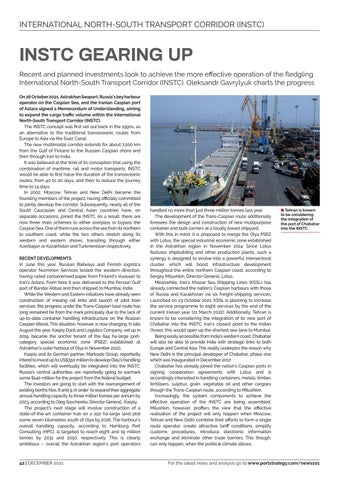INTERNATIONAL NORTH-SOUTH TRANSPORT CORRIDOR (INSTC)
INSTC GEARING UP Recent and planned investments look to achieve the more effective operation of the fledgling International North-South Transport Corridor (INSTC). Oleksandr Gavrylyuk charts the progress On 26 October 2021, Astrakhan Seaport, Russia’s key harbour operator on the Caspian Sea, and the Iranian Caspian port of Astara signed a Memorandum of Understanding, aiming to expand the cargo traffic volume within the International North-South Transport Corridor (INSTC). The INSTC concept was first set out back in the 1990s, as an alternative to the traditional transoceanic routes from Europe to Asia via the Suez Canal. The new multimodal corridor extends for about 7,200 km from the Gulf of Finland to the Russian Caspian shore and then through Iran to India. It was believed at the time of its conception that using the combination of maritime, rail and motor transports, INSTC would be able to first halve the duration of the transoceanic routes, from 40 to 20 days, and then to reduce the journey time to 14 days. In 2002, Moscow, Tehran and New Delhi became the founding members of the project, having officially committed to jointly develop the corridor. Subsequently, nearly all of the South Caucasian and Central Asian countries have, on separate occasions, joined the INSTC. As a result, there are now three main schemes to either overpass or bypass the Caspian Sea. One of them runs across the sea from its northern to southern coast, while the two others stretch along its western and eastern shores, transiting through either Azerbaijan or Kazakhstan and Turkmenistan respectively. RECENT DEVELOPMENTS In June this year, Russian Railways and Finnish logistics operator Nurminen Services tested the western direction, having railed containerised paper from Finland’s Vuosaari to Iran’s Astara. From here it was delivered to the Persian Gulf port of Bandar Abbas and then shipped to Mumbai, India. While the Western and Eastern initiatives have already seen construction of missing rail links and launch of pilot train services, the progress under the Trans-Caspian (sea) route has long remained far from the mark principally due to the lack of up-to-date container handling infrastructure on the Russian Caspian littoral. This situation, however, is now changing. In late August this year, Kaspiy Dock and Logistics Company, set up in 2019, became the anchor tenant of the 644 ha-large portcategory special economic zone (PSEZ) established at Astrakhan’s outer harbour of Olya in November 2020. Kaspiy and its German partner, Martrade Group, reportedly intend to invest up to US$350 million to develop Olay’s handling facilities, which will eventually be integrated into the INSTC. Russia’s central authorities are reportedly going to earmark some $140 million for the project from the federal budget. The investors are going to start with the rearrangement of existing berths Nos. 8 and 9, in order to expand their aggregate annual handling capacity to three million tonnes per annum by 2023, according to Oleg Savchenko, Director General, Kaspiy. The project’s next stage will involve construction of a state-of-the-art container hub on a 250 ha-large land plot some seven kilometres south of Olya by 2026. The harbour’s overall handling capacity, according to Hamburg Port Consulting (HPC), is targeted to reach eight and 19 million tonnes by 2031 and 2050, respectively. This is clearly ambitious – overall the Astrakhan region’s port operators
42 | DECEMBER 2021
handled no more than just three million tonnes last year. The development of the Trans-Caspian route additionally foresees the design and construction of new multipurpose container and bulk carriers at a locally based shipyard. With this in mind, it is proposed to merge the Olya PSEZ with Lotus, the special industrial economic zone established in the Astrakhan region in November 2014. Since Lotus features shipbuilding and other production plants, such a synergy is designed to evolve into a powerful intersectoral cluster, which will boost infrastructure development throughout the entire northern Caspian coast, according to Sergey Milushkin, Director General, Lotus. Meanwhile, Iran’s Khazar Sea Shipping Lines (KSSL) has already connected the nation’s Caspian harbours with those of Russia and Kazakhstan via six freight-shipping services. Launched on 23 October 2021, KSSL is planning to increase the service programme to eight services by the end of the current Iranian year (21 March 2022). Additionally, Tehran is known to be considering the integration of its new port of Chabahar into the INSTC. Iran’s closest point to the Indian Ocean, this would open up the shortest sea-lane to Mumbai. Being easily accessible from India’s western coast, Chabahar will also be able to provide India with strategic links to both Europe and Central Asia. This reality underpins the reason why New Delhi is the principal developer of Chabahar, phase one which was inaugurated in December 2017. Chabahar has already joined the nation’s Caspian ports in signing cooperation agreements with Lotus and is accordingly interested in handling containers, metals, timber, fertilisers, sulphur, grain, vegetable oil and other cargoes though the Trans-Caspian route, according to Milushkin. Increasingly, the system components to achieve the effective operation of the INSTC are being assembled. Milushkin, however, proffers the view that the effective realisation of the project will only happen when Moscow, Tehran and New Delhi combine their efforts to form a single route operator, create attractive tariff conditions, simplify customs procedures, introduce electronic information exchange and eliminate other trade barriers. This though, can only happen, when the political climate allows.
8 Tehran is known to be considering the integration of the port of Chabahar into the INSTC
For the latest news and analysis go to www.portstrategy.com/news101














